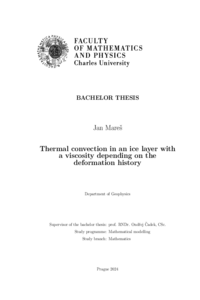Thermal convection in an ice layer with a viscosity depending on the deformation history
Termální konvekce v ledové vrstvě s viskozitou závislou na historii deformace
bachelor thesis (DEFENDED)

View/
Permanent link
http://hdl.handle.net/20.500.11956/193702Identifiers
Study Information System: 264409
Collections
- Kvalifikační práce [11423]
Author
Advisor
Consultant
Kihoulou, Martin
Referee
Souček, Ondřej
Faculty / Institute
Faculty of Mathematics and Physics
Discipline
Mathematical Modelling
Department
Department of Geophysics
Date of defense
12. 9. 2024
Publisher
Univerzita Karlova, Matematicko-fyzikální fakultaLanguage
English
Grade
Excellent
Keywords (Czech)
ledové měsice|termální konvekce|konečné prvky|vývoj velikosti zrnaKeywords (English)
thermal convection|icy moons|finite elements|grain size evolutionTermální konvekce je klíčový proces ovlivňující přenos tepla, vnitřní strukturu ledové slupky a potenciální obyvatelnost ledových měsíců ve vnější sluneční soustavě. Přestože vliv velikosti zrn na chování termální konvekce je dobře znám, modely zahrnující vývoj velikosti zrna spolu s realistickými materiálnovými parametry jsou vzácné. V této práci představujeme numerický model, který zkoumá vliv vývoje velikosti zrn na tepelnou konvekci v ledových pláštích těchto měsíců. Model využívá metodu konečných prvků a metodu tracerů implementovanou v softwaru FEniCS a zahrnuje dynamicky se vyvíjející velikost zrn. Naše výsledky naznačují, že chování modelu se podobá modelům s kon- stantní velikostí zrn, což naznačuje, že předpoklad konstantní velikosti zrn je rozumným zjednodušením. Oblasti s menšími velikostmi zrn kopírují oblasti s vyšším napětím, za- tímco jinde velikost zrna dosahuje svého maxima. To zdůrazňuje nutnost dalšího výzkumu maximální velikosti zrna v ledových slupkách měsíců. 1
Thermal convection in the ice layer is a crucial process influencing heat transfer, the internal structure of the icy shell and the potential habitability of icy moons in the outer Solar System. Despite the known significant impact of the grain size on thermal convection behaviour, only few models have integrated grain size evolution with realistic material parameters. In this study, we develop a numerical model to investigate the effect of grain size on thermal convection in the icy shells of these moons. Utilizing the finite-element method and a tracer method implemented in the FEniCS software, the model incorporates dynamically evolving grain size with realistic constitutive relations. Our findings indicate that the behaviour of our model closely mirrors those with constant grain size, suggesting that a constant grain size is a reasonable simplification. Regions with smaller grain sizes align with areas of higher stress, while elsewhere, the grain size reaches its maximum. This underscores the necessity of further research into the maximum grain size threshold. 1
